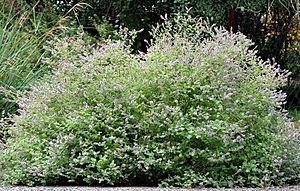Mentha gattefossei facts for kids
Quick facts for kids Mentha gattefossei |
|
|---|---|
 |
|
| Conservation status | |
| Scientific classification | |
| Genus: |
Mentha
|
| Species: |
gattefossei
|
Mentha gattefossei is a special kind of mint plant. It grows only in the Atlas Mountains of Morocco. This plant was first described by a French botanist named René Maire in 1922. People use M. gattefossei for its essential oil. It has also been used in traditional medicine, to keep pests away, and to add flavor to food.
What's in a Name?
When René Maire first described this mint in 1922, he named it Mentha gattefossei. He did this to honor another botanist, Jean Gattefossé. Jean Gattefossé had done a lot of important work studying Moroccan herbs and plants that smell nice.
This plant has a few common names. In Arabic, it's called Fliyyo dial jbel. In French, people sometimes call it Menthe de Perse or Menthe de Gatefossé.
Plant Family Tree
Mentha gattefossei is officially recognized as its own unique species of mint. For a long time, scientists thought it was closely related to other mints like Mentha pulegium. This was because they looked similar in some ways.
However, a study in 2004 looked at the plant's chloroplast DNA. This is like looking at a plant's genetic code to understand its family history. The study showed that M. gattefossei is actually more closely related to Mentha cervina. They even share some tiny changes in their DNA. Both of these mints, along with Mentha requienii, are now grouped together. They are all special plants that grow around the Mediterranean Sea. Like some other mints, M. gattefossei has 10 chromosomes in its basic set.
It's hard for M. gattefossei to mix with other mints and create hybrid plants. If they do, the new plants are often weak and can easily get sick.
How to Spot It
Mentha gattefossei is a plant that lives for many years. It has roots that spread underground. Its stems grow about 20 to 30 centimeters (8 to 12 inches) tall. The leaves are small, about 1 to 1.5 centimeters long. They are smooth and grow directly on the stem without a stalk.
The flowers grow in clusters. They are whitish and about 4 to 5 millimeters long. One special thing about Mentha gattefossei is that it has a white tip on each part of its flower cup. Only one other mint, M. cervina, shares this feature. You can tell M. gattefossei apart from M. cervina by counting the parts of its flower cup.
In its natural home, this mint blooms in June and July. Studies have shown that about 70% of its seeds can sprout and grow into new plants.
The main parts of its essential oil are pulegone (about 68%) and menthone (about 10%). These chemicals give the plant its unique smell and properties.
Where It Grows
Mentha gattefossei is found only in certain parts of Morocco. These areas include the High Atlas, Middle Atlas, Anti Atlas, and Saharan regions. The total area where it grows is quite small, about 500 square kilometers (193 square miles).
It mostly grows near "dayas," which are pools that dry up in the summer in the Atlas Mountains. You can also find it in other wet places, like river banks, irrigation canals, and damp fields.
Because it grows in such a small area, it's considered one of the rarest plants in the world. Scientists believe that climate change could harm many plants in the Mediterranean region, including this rare mint. To help protect it, scientists are trying to grow more of it. They have found ways to grow many new plants from small pieces of the original plant in a lab. This method can help save the species.
How People Use It
People use Mentha gattefossei for its essential oil. They also use it as a fragrant herb in food and teas. In Morocco, people have traditionally made a drink from it to help with general health. The chemicals in its essential oil, like pulegone and menthone, are thought to have antioxidant properties, which means they can help protect the body's cells.
Unfortunately, harvesting this plant for medicine and food is one reason why it's becoming rarer in the wild. In Morocco, people also use its strong scent to keep insects away from dried figs they store.




